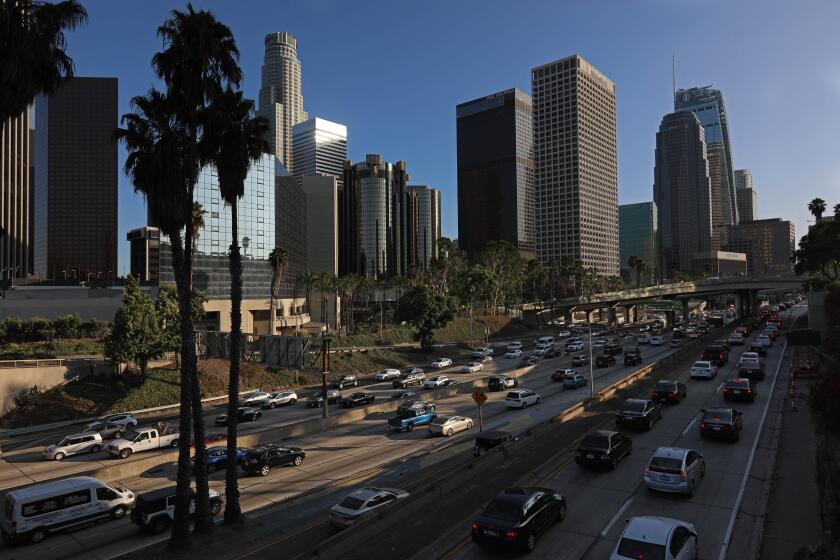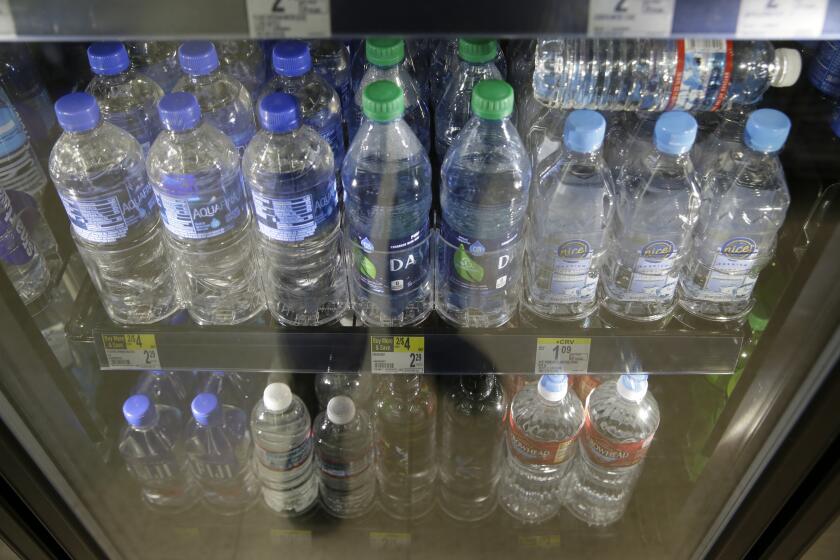Ever wonder where your drinking water comes from? A reader asked and we answer

- Share via
This summer, we began asking readers to submit their most pressing business-related questions about Los Angeles and California.
Then we put the questions to a vote, allowing readers to decide which question we would answer in story form.
Our latest selection was submitted by Nelson Rheem: Why doesn’t L.A. pump its underground water up, process it to remove the impurities and distribute it locally in the L.A. area?
The answer: L.A. does pump and use local groundwater — but other water sources are important for replenishing the supply.
Until the first half of the 20th century, some areas in Los Angeles County had very high groundwater and springs that residents could use as a water source, said Madelyn Glickfeld, co-director of the UCLA Water Resources Group.
“With growth, wells had to be dug deeper and deeper using newly invented drilling and pumping technology,” she said via email.
Eventually, “we started running out of groundwater,” Glickfeld said, leading to the use of imported water via the State Water Project.
We picked our favorite questions — now you get to choose which question we answer first.
Imported water
Today, the majority of L.A.’s water comes from imported sources such as the Los Angeles Aqueduct system, built during the 20th century to transport water from the Mono Basin and Owens Valley to Los Angeles.
But imported water is not the only method of replenishing L.A.’s basins.
“The water sector has looked for ways to replenish groundwater basins more sustainably,” said Rebecca Kimitch, press office manager at the Metropolitan Water District of Southern California. “Imported sources, those are limited and they’re having more stretch because of climate change.”
Sales of bottled water have soared during the pandemic. Many Americans may not realize they’re just paying a huge markup for tap water.
Stormwater
L.A.’s development is a challenge for rainwater capture, said Melanie Winter, founder and director of the River Project, a nonprofit organization that encourages responsible management of watershed lands and revitalization of rivers. The spread of asphalt and other human-made surfaces resulted in a loss of permeable surface area where rainwater can absorb into the ground.
“We have not allowed for the preservation of adequate open space, which reduces temperatures, sequesters carbon, provides habitat and biodiversity [and] allows rainwater to get into the groundwater basin,” she said.
The Los Angeles County Department of Public Works captures some local stormwater through a system of dams, reservoirs and spreading grounds. In this way, the agency captures a third of the drinking water supply for Los Angeles County, director Mark Pestrella said.
In 2018, the county enacted a property tax designed to raise money to capture and treat stormwater. Through Measure W, “we’re likely going to be able to capture in the next 20 to 30 years something like an additional 300,000 acre-feet on an average annual basis, Pestrella said.
Recycled water
Recycled water — wastewater from our sinks, showers, toilets and beyond that is purified through multiple levels of treatment — also plays a role in L.A.’s groundwater system.
“Recycled water right now is a small piece, but in the future, it will be a big piece,” said Paul Liu, a manager within the L.A. Department of Water and Power’s water resources division.
“With climate change, imported water is becoming less and less viable,” said Stephan Tucker, general manager of the Water Replenishment District of Southern California. Through the use of recycled water, “the goal is to be locally sustainable so that we are less and less dependent on imported water.”
How does water end up getting recycled?
“We take water from the L.A. County Sanitation District, 14.8 million gallons a day, we treat it and use that water for infiltration into the Montebello Forebay,” an area in southeast L.A. County where groundwater is replenished via a system of spreading grounds and dams, said Angie Mancillas, manager of external affairs at the Water Replenishment District.
“Eventually that water is pumped from the underground aquifers by water providers and distributed to their customers,” Mancillas said via email. “It has helped southern L.A. County reduce its reliance on imported water.”
So how much groundwater do we actually use?
In recent years, groundwater has made up a fairly small percentage of L.A.’s water supply. “The reason for that is because of historical contamination,” especially within the San Fernando Basin, Liu said.
“In the ’40s, as the Valley started getting industrialized, companies moved in — manufacturing, aerospace — and a lot of the contamination was just buried in the ground,” making its way into the basin, Liu said.
To return the basin to a more productive state, the DWP is in the process of building three groundwater treatment facilities, Liu said. “As we pull the water out, it’s going to be treated to meet all state and federal standards … [and] all permit requirements [that make it] suitable for drinking.”
Groundwater has constituted about 10% of L.A.’s overall supply of drinking water in the last five years, Liu said. In the future, the goal is for a larger amount of L.A.’s drinking water to come from the basin thanks to these treatments, he said.
Imported water is still important
Ultimately, water conservation efforts and an enhanced local water supply “could someday get us to a place where we aren’t actually in need of daily imported water,” Pestrella said.
But, with California’s propensity for drought and the realities of climate change, that doesn’t mean imported water will become a thing of the past.
“I think it’s important to understand that imported water will always be necessary to drought-proof our water portfolio,” Pestrella said.
One last thing
Those interested in learning more about the water system — as well as the process of treating and using recycled water — can take a virtual tour of the Albert Robles Center for Water Recycling and Environmental Learning.
In the future, the center hopes to reopen for in-person tours. “We have a room where you can actually taste the product water when it comes through the system,” Mancillas said. “It’s pretty much a groundwater museum.”
Do you have a pressing question about Los Angeles and California that you’d like us to answer? Let us know using this form.
More to Read
Inside the business of entertainment
The Wide Shot brings you news, analysis and insights on everything from streaming wars to production — and what it all means for the future.
You may occasionally receive promotional content from the Los Angeles Times.













